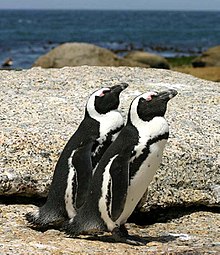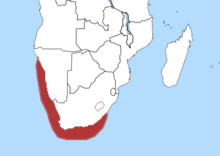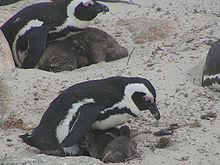African penguin
Carl
| African Penguin | |
|---|---|

| |
| Scientific classification | |
| Kingdom: | |
| Phylum: | |
| Subphylum: | |
| Class: | |
| Order: | |
| Family: | |
| Genus: | |
| Species: | S. demersus
|
| Binomial name | |
| Spheniscus demersus | |

| |
| Distribution of the African Penguin | |
The African Penguin (Spheniscus demersus), also known as the Black-footed Penguin is a species of penguin, confined to southern African waters. It is also widely known as the "Jackass" Penguin for its donkey-like bray, although several related species of South American penguins produce the same sound. Like all penguins it is flightless, with a streamlined body, and wings stiffened and flattened into flippers for a marine habitat. Adults weigh on average 2.2–3.5 kg (4.9–7.7 lb) and are 60–70 cm (24–28 in) tall. It has distinctive pink patches of skin above the eyes and a black facial mask; the body upperparts are black and sharply delineated from the white underparts, which are spotted and marked with a black band. This pink gland above their eyes helps them to cope with changing climates. When the temperature gets hotter, the body of the African Penguin sends more blood to these glands to be cooled by the air surrounding it. This then causes the gland to turn a darker shade of pink. [2]
The African Penguin is a pursuit diver and feeds primarily on fish and. Once extremely numerous, the African Penguin is declining due to a combination of threats and is classified as endangered. It is a charismatic species and is popular with tourists in the region.
Taxonomy
The African Penguin was one of the many bird species originally described by Linnaeus in the landmark 1758 10th edition of his Systema Naturae, where he grouped it with the Wandering Albatross on the basis of its bill and nostril morphology and gave it the name Diomedea demersa.[3]
The African Penguin is a banded penguin, placed in the genus Spheniscus. The other banded penguins are the African Penguin's closest relatives, and are all found mainly in the Southern Hemisphere: the Humboldt Penguin and Magellanic Penguins found in southern South America, and the Galápagos Penguin found in the Pacific Ocean near the equator. All are similar in shape, colour and behaviour.
The African Penguin is a member of the class Aves, and the order Sphenisciformes. It belongs to the penguin family Spheniscidae. It is classified as Spheniscus demersus, which is somewhat descriptive about its behavior when analysed with etymology.
Etymology
The genus to which the African Penguin belongs to, Spheniscus, derives from the Ancient Greek word sphen, which means wedge. This refers to their streamlined body shape. Its species name, demersus, is a Latin word for "plunging".[4]
Description

African Penguins grow to 60–70 cm (24–28 in) tall and weigh between 2.2–3.5 kg (4.9–7.7 lb).[5] They have a black stripe and black spots on the chest, the pattern of spots being unique for every penguin, like human fingerprints. They have pink glands above their eyes, which are used for thermoregulation. The hotter the penguin gets, the more blood is sent to these glands so it may be cooled by the surrounding air, thus making the glands more pink.[6] This species exhibits slight sexual dimorphism: the males are larger than the females and have larger beaks.[7] Juveniles do not possess the bold, delineated markings of the adult but instead have dark upperparts that vary from greyish-blue to brown; the pale underparts lack both spots and the band. The beak is more pointed than that of the Humboldt. Their distinctive black and white colouring is a vital form of camouflage called countershading– white for underwater predators looking upwards and black for predators looking down onto the dark water. African penguins look similar and are thought to be related to the Humboldt, Magellanic, and Galapagos penguins.[8] African penguins have a very recognizable appearance with a thick band of black that is in the shape of an upside-down horseshoe. They have black feet and unique black spots that vary in size and shape per penguin. Magellanic Penguins share a similar characteristic that often confuses the two, the similarity is a double bar on the throat and chest. These penguins have the nickname of "Jackass penguin" which comes from the loud noises they make.
Distribution
The African Penguin is found on the south-western coast of Africa, living in colonies on 24 islands between Namibia and Algoa Bay, near Port Elizabeth, South Africa.[1] It is the only penguin species that breeds in Africa and its presence gave name to the Penguin Islands.

Two colonies were established by penguins in the 1980s on the mainland near Cape Town, namely Boulders Beach near Simon's Town and Stony Point in Betty's Bay. Mainland colonies probably only became possible in recent times due to the reduction of predator numbers, although the Betty's Bay colony has been attacked by leopards.[9] The only other mainland colony is in Namibia, but it is not known when this was established.
Boulders Beach is a tourist attraction, for the beach, swimming and the penguins.[10][11] The penguins will allow people to approach them as close as a metre.
Biology
Diet
African Penguins forage in the open sea, where they pursue pelagic fish such as pilchards and anchovies (e.g. Engraulis capensis),[12] and marine invertebrates such as squid and small crustaceans.[13] Penguins normally swim within 20 km of the shore.[14] A penguin may consume up to 540 grams of prey every day,[15] but this may increase to over 1 kg when raising older chicks.[13]
Due to the collapse of a commercial pilchard fishery in 1960, the African penguin has resorted to eating anchovies. Although it keeps the penguins alive, it is not their ideal meal due to the low concentration of fat and protein. Their diet changes throughout the year and it is believed that their aspect of breeding help the penguins maintain their population size. Upon having hatchlings, although the parent penguins are protective of their hatchlings, the parents will not sacrifice their appetite for their children. If even in a situation where food is scarce, adult parents will let their children starve before they let themselves starve.
Breeding
The African Penguin is monogamous.[4] It breeds in colonies, and pairs return to the same site each year. The African Penguin has an extended breeding season,[4] with nesting usually peaking from March to May in South Africa, and November and December in Namibia.[12] A clutch of two eggs are laid either in burrows dug in guano, or scrapes in the sand under boulders or bushes. Incubation is undertaken equally by both parents for about 40 days. At least one parent guards the chicks until about 30 days, whereafter the chick joins a creche with other chicks, and both parents head out to sea to forage each day.
Chicks fledge at 60 to 130 days, the timing depending on environmental factors such as quality and availability of food. The fledged chick then go to sea on their own and return to their natal colony after a lengthy time period of 12–22 months to molt into adult plumage.[4]
When penguins molt, they are unable to forage as their new feathers are not waterproof yet; therefore they fast over the entire molting period, which in African Penguins takes about 20 days.[4]
African penguin females remain fertile for 10 years. Penguins spend most of their lives at sea until it comes time for them to lay their eggs. Due to the high predation by larger mammals on the mainland, the penguins will go offshore to an island for protection from mammals and natural challenges. African penguins usually breed during the African winter when temperatures are cooler. Although it is winter, the heat on the island is still scorching, therefore the penguins dig holes in the layers of guano and incubate the eggs there. Due to humans, though, the amount of guano on the land has significantly dropped. To compensate, penguins dig holes in the sand. Although effective, the sand gets hot and fills with water during rain easily. The penguins spend three weeks on land to provide for their offsprings. The eggs are 3-4 times bigger than hen’s eggs. Parents usually feed hatchlings during dusk or dawn.
Predation
The average lifespan of an African Penguin is 10 to 27 years in the wild, and possibly longer in captivity.[16] However, the African Penguin may often fall to predators.
Their predators in the ocean include sharks, Cape Fur Seals and, on occasion, orcas. Land-based enemies include mongooses, genets, domestic cats, and the Kelp Gull which steals their eggs and newborn chicks.[17]
During their lives, penguins will be hunted by sharks in the water and large mammals on land. They are also affected through ingestion of oil from oil spills and shipwrecks. Finally, they are hunted extensively by humans for various reasons.
Conservation
The main project in place to protect the African penguin is conducted through The Baywatch Marine Conservation Project. They are the only organization with a permit to conduct research on St Croix Island, the largest African penguin colony. They are part funded by Raggy Charters and were founded by Lloyd Edwards of Port Elizabeth.[citation needed]
Threats

- Background
Of the 1.5-million African Penguin population estimated in 1910, only some 10% remained at the end of the 20th-century. African penguin populations, which breed in Namibia and South Africa, have declined by 95 percent since preindustrial times.[18]
Commercial fisheries have forced these penguins to search for prey farther off shore, as well as making them eat less nutritious prey, since their preferred prey has become scarce.[18] Global climate change is also affecting these penguins' prey abundance.
As recently as the mid-twentieth century, penguin eggs were considered a delicacy and were still being collected for sale. Unfortunately, the practice was to smash eggs found a few days prior to gathering, to ensure that only fresh ones were sold. This added to the drastic decline of the penguin population around the Cape coast, a decline which was hastened by the removal of guano from islands for use as fertilizer, eliminating the burrowing material used by penguins. Penguins remain susceptible to pollution of their habitat by petrochemicals from spills, shipwrecks and cleaning of tankers while at sea.
- 2000 MV Treasure crisis
Disaster struck on 23 June 2000, when the iron ore tanker MV Treasure sank between Robben Island and Dassen Island, South Africa. It released 1,300 tons of fuel oil, causing an unprecedented coastal bird crisis,[19] oiling 19,000 adult penguins at the height of the best breeding season on record for this vulnerable species. The oiled birds were brought to an abandoned train repair warehouse in Cape Town to be cared for. An additional 19,500 un-oiled penguins were removed from Dassen Island and other areas before they became oiled, and were released about 800 kilometres east of Cape Town, near Port Elizabeth. This gave workers enough time to clean up the oiled waters and shores before the birds could complete their long swim home (which took the penguins between 1 and 3 weeks). Some of the penguins were named and radio-tracked as they swam back to their breeding grounds. Tens of thousands of volunteers descended upon Cape Town to help with the rescue and rehabilitation process, which was overseen by IFAW (International Fund for Animal Welfare) and the South African Foundation for the Conservation of Coastal Birds (SANCCOB), and took more than three months to complete. This was the largest animal rescue event in history; more than 91% of the penguins were successfully rehabilitated and released - an amazing feat that could not have been accomplished without such a tremendous international response.[20]
Conservation status
The African Penguin is one of the species to which the Agreement on the Conservation of African–Eurasian Migratory Waterbirds (AEWA) applies. The African Penguin is listed in the Red Data Book as an endangered species.[1]
In September 2010, the African Penguin was listed as endangered under the U.S.A Endangered Species Act.[18]
Roughly 4 million penguins existed at the beginning of the last century. The total population fell to 200,000 in the year 2000; ten years later, in 2010, the number was estimated to be only at 55,000. If this decline is not halted, the African Penguin is expected to be extinct within 15 years.[21]
5,000 breeding pairs were estimated to live in Namibia in 2008; in 2009, about 21,000 pairs were estimated to live in South Africa.[1]
Mediation efforts
Many organisations such as SANCCOB, Dyer Island Conservation Trust and SAMREC in Port Elizabeth are working to halt the decline of the African Penguin, through various measures: monitoring population trends, hand-rearing and releasing abandoned chicks, setting up artificial nests, and proclaiming marine reserves where fishing is prohibited.[1]
See also
References
- ^ a b c d e Template:IUCN
- ^ a-z animals. "The African Penguin". a-z animals. Retrieved 2013-07-09.
- ^ Linnaeus, Carl (1758). Systema Naturae per Regna Tria Naturae, Secundum Classes, Ordines, Genera, Species, cum Characteribus, Differentiis, Synonymis, Locis. Tomus I. Editio decima, reformata (in Latin). Holmiae: (Laurentii Salvii). p. 132.
- ^ a b c d e http://www.penguins.cl/african-penguins.htm
- ^ Sinclair, Ian; Hockey, Phil; Tarboton, Warwick; Ryan, Peter (2011). Sasol Birds Of South Africa. Struik. p. 22. ISBN 9781770079250.
{{cite book}}: CS1 maint: multiple names: authors list (link) - ^ Mahard, Tyler (2012). "The Black-footed Penguin Spheniscus demersus". Wildlife Monthly. Retrieved 2012-11-20.
- ^ "African Penguin (Speheniscus demersus)". Dyer Island Conservation Trust. Archived from the original on 26 October 2009.
- ^ "African Penguin". Retrieved 2013-01-30.
{{cite web}}: Unknown parameter|deadurl=ignored (|url-status=suggested) (help) - ^ "The African Penguin". Bettysbay.info. 2010-04-08. Retrieved 2012-03-30.
- ^ "Table Mountain National Park". SANParks. Retrieved 2012-03-30.
- ^ "Boulders Beach, Swimming with Penguins - Swimming with Penguins in South Africa". Goafrica.about.com. 2010-06-14. Retrieved 2012-03-30.
- ^ a b "African penguin videos, photos and facts - Spheniscus demersus". ARKive. Retrieved 2012-03-30.
- ^ a b "The African Penguin Simons Town". Simonstown.com. Retrieved 2012-03-30.
- ^ Sinclair, Ian; Hockey, Phil; Tarboton, Warwick; Ryan, Peter (2011). Sasol Birds Of South Africa. Struik. p. 22. ISBN 9781770079250.
{{cite book}}: CS1 maint: multiple names: authors list (link) - ^ "Betty's Bay African Penguin Colony". Viewoverberg.com. Retrieved 2012-03-30.
- ^ "ADW: Spheniscus demersus: INFORMATION". Animaldiversity.ummz.umich.edu. 2010-02-01. Retrieved 2012-03-30.
- ^ "African penguin". Neaq.org. Retrieved 2012-03-30.
- ^ a b c [1] Vanishing African Penguin, Threatened by Climate Change and Fishing, Wins Protections Cite error: The named reference "African Penguin" was defined multiple times with different content (see the help page).
- ^ http://www.sanccob.co.za/?m=2&s=5&idkey=625
- ^ ""Jackass Penguins Freed after Rehab", National Geographic's Video News, June 17, 2009". News.nationalgeographic.com. 2010-10-28. Retrieved 2012-03-30.
- ^ "African Penguin | Endangered | Cape Town". Globalpost.com. 2011-06-19. Retrieved 2012-03-30.
External links
- African Penguin (Jackass Penguin) - Species text in The Atlas of Southern African Birds.
- Penguin Watch "Penguins: ambassadors for marine biodiversity" - [2]
- California Academy of Sciences: Web cams, mobile app and blog
- Monterey Bay Aquarium: Web cams and info
- ARKive there are African Penguins - Images and movies of the African penguin
- African Penguins from the International Penguin Conservation Web Site
- African Penguins - Avian Demography Unit at the University of Cape Town
- Stony Point penguin colony
- African Penguins on the SANCCOB conservation website
- African penguins at PenguinWorld website
- New England Aquarium: African Penguin Exhibit & Information
- Van Heezik, Yolanda, and Phillip Seddon. "Natural History." Natural History. 106.9 (1997): n. page. Web. 17 Oct. 2012. <http://ehis.ebscohost.com.proxy.libraries.rutgers.edu/ehost/detail?sid=bc89e52a-b1ab-4183-bd6c-0423cff2ea72@sessionmgr10&vid=9&hid=23&bdata=JnNpdGU9ZWhvc3QtbGl2ZQ==
- "Penguins." PENGUINS - Scientific Classification. SeaWorld, 21 Oct. 2012. Web. 21 Oct. 2012. <http://www.seaworld.org/animal-info/info-books/penguin/scientific-classification.htm>.
- . "Penguins's Around the World." . N.p.. Web. 20 Oct 2012. <http://www.siec.k12.in.us/west/proj/penguins/africanpen.html>

